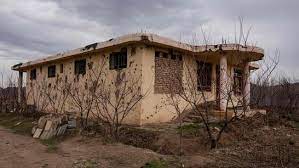
Taliban sniper Damullah Mohibullah Mowaffaq becomes mayor of Afghan town
Walking through the city of Maymana, the new mayor appeared to inspire goodwill from the war-tired constituents in the provincial capital of Afghanistan.
But Damullah Mohibullah MouraFFAQ has a reputation as one of the top snipers in the Taliban ranks, until the payroll war last summer to take control of the country.
Mouraffaq was made mayor Mayor, the capital of Faryab Province in the northwestern corner of Afghanistan, in November, three months after the Taliban overthrew the government supported by the West and the power seized.
He became famous as a warrior, but now the schedule is packed with the daily task of the local government – blocking gutter, road planning, and smoothing on environmental quarrels.
His move reflected a broader transformation that the Taliban was undergoing, as rebels wrestling with regional giving.
When I fought my very specific purpose: to end a foreign occupation, discrimination and injustice, “25 years to AFP.
Now my goal is also clear: To fight corruption and make a prosperous country”
On the streets through the streets of Maymana, the new mayor spoke with city workers cleaning the roadside gutter.
City residents 100,000 approaches with complaints and suggestions, which are adopted added to a to-do list which continues to grow.
The new mayor of young, educated and very important, from the city, “said the deputy non-Taliban, Sayed Ahmad Shah Gheyasi.
“He knows how to deal with people.”
Unlike poor people, madrasah-educated rural people who made the Taliban and file rank, Mouraffaq came from a rich trader family and grew up in Maymana, where he was superior in school and in sports.
Memorabilia from his youth adorn his office including a certificate from the competition of martial arts and high school diplomas.
After joining the rebellion in 19, he was promoted to lead a small unit deployed in Faryab Province.
Others described him as one of the most gifted Taliban snipers, even though he seemed reluctant to be pulled to tell the story of war.
But in walkabout with AFP he stopped in front of a rusty house with a sign of a gunpowder near the village of Doraye Khoija Qoshre, where the unit once held swayed.
Here he used to hide himself, scoping American troops with his rifle and honing the reputation as a crack shot.
“He killed an American with his rifle from this house, then the plane came and bombed him,” said Saifaddin, a local farmer, who like many in Afghanistan walked one name.
Although it could not be confirmed Mousaffaq was responsible, in mid-2019 the United States announced members of their special forces have been killed in battle in Faryab.
A year earlier, Afghan analyst network said Maymana was “practical under the siege” because “the presence of the surprisingly broad Taliban”.
Mourafffaq witnessed several friends killed in battle but still dodged about the horror he was well caused and suffered.
But in Mouraffaq’s office, female employees have been allowed to keep working, and public parks in the city are reserved for them.
Under the first Taliban regime of 1996-2001, the Burqa all-covers are mandatory for women.
This time, religious police have stopped from making the same dictate – even though they have issued orders for women in the capital to cover their faces.
At the Maymana Mayor’s office, “no one tells us how to dress,” said Qahera, a 26-year-old female director of human resources, who wear headscarves in line with the current dress requirements.
Lightning Taliban takeover from Afghanistan took even members of the surprised movement.
Their efforts to run the country are slaughtered by mere experience, brain drain, humanitarian crisis, and pressure from Western forces who have frozen assets.

